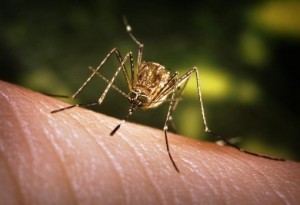Iowa sees first human West Nile virus case of 2014 in Clay County man
The Iowa Department of Public Health (IDPH) announced Tuesday the first confirmed human case of West Nile virus (WNV) in Iowa this year. The case is an adult male (18 to 40 years of age) from Clay County, who is recovering. “This West Nile case should serve as notice that the virus is out there and Iowans should take precautions,” said IDPH Medical Director, Dr. Patricia Quinlisk.

Image/CDC
WNV is spread by the bite of an infected mosquito. Mosquitoes are WNV carriers that become infected when they feed on infected birds. Infected mosquitoes can then spread WNV to humans and other animals when they bite. Rarely, WNV also has spread through transfusions, transplants, and mother-to-child.
Approximately 80 percent of people who are infected with WNV will not show any symptoms at all. Up to 20 percent of the people who become infected will display mild symptoms, which appear 3-14 days after getting infected, and include fever, headache, and body aches, nausea, vomiting, and sometimes swollen lymph glands or a skin rash on the chest, stomach and back. Symptoms typically last a few days.
About one in 150 people infected with WNV will develop severe illness. The severe symptoms can include high fever, headache, neck stiffness, stupor, disorientation, coma, tremors, convulsions, muscle weakness, vision loss, numbness and paralysis. These symptoms may last several weeks, andneurological effects may be permanent. There is no specific treatment for WNV infection. Prevention is by avoiding mosquito bites and eliminating mosquito breeding sites. For more infectious disease news and information, visit and “like” the Infectious Disease News Facebook page
Recent heavy rains and flooding in Iowa could lead to an increased number of mosquitoes this summer. These ‘flood’ mosquitoes rarely carry the West Nile virus; therefore, heavy rain and flooding don’t necessary result in increased West Nile virus cases. Mosquitoes carrying West Nile virus tend to lay eggs in stagnant water. This is why it’s important to eliminate standing water. If flood waters pool and become stagnant in ditches or other recesses, it is possible West Nile virus-carrying mosquitoes could breed there as well. It is when flood water lies stagnant for several weeks the threat of mosquitoes carrying West Nile virus increases.
Since West Nile first appeared in Iowa in 2002, it has been found in every county in Iowa, either in humans, horses, or birds. In 2013, there were 44 human cases of West Nile virus and zero deaths.
Nationally, the Centers for Disease Control and Prevention (CDC) reported 2,374 WNV cases and 114 deaths in 2013. This was a far cry from the 2012 outbreak that had a final total of 5,674 cases of West Nile virus disease in people, including 286 deaths.















[…] One case from San Joaquin County was an asymptomatic infection. However, not counted in the CDC data are cases from Stanislaus (1) and Tulare (1) counties in California and one case from Iowa. […]